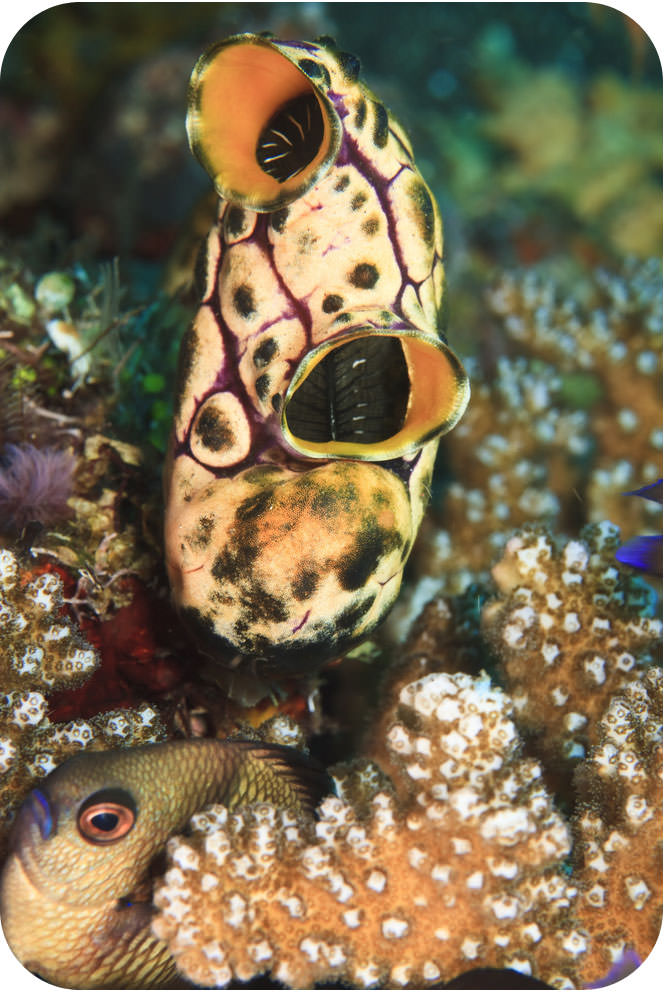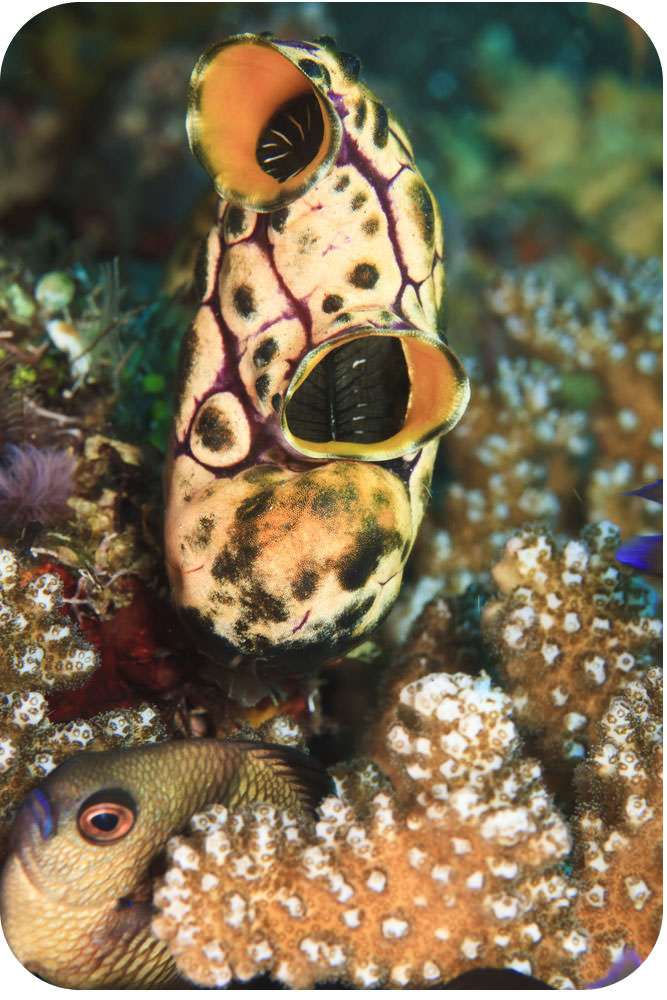11.4: Invertebrate Chordates
- Page ID
- 13227
\( \newcommand{\vecs}[1]{\overset { \scriptstyle \rightharpoonup} {\mathbf{#1}} } \)
\( \newcommand{\vecd}[1]{\overset{-\!-\!\rightharpoonup}{\vphantom{a}\smash {#1}}} \)
\( \newcommand{\dsum}{\displaystyle\sum\limits} \)
\( \newcommand{\dint}{\displaystyle\int\limits} \)
\( \newcommand{\dlim}{\displaystyle\lim\limits} \)
\( \newcommand{\id}{\mathrm{id}}\) \( \newcommand{\Span}{\mathrm{span}}\)
( \newcommand{\kernel}{\mathrm{null}\,}\) \( \newcommand{\range}{\mathrm{range}\,}\)
\( \newcommand{\RealPart}{\mathrm{Re}}\) \( \newcommand{\ImaginaryPart}{\mathrm{Im}}\)
\( \newcommand{\Argument}{\mathrm{Arg}}\) \( \newcommand{\norm}[1]{\| #1 \|}\)
\( \newcommand{\inner}[2]{\langle #1, #2 \rangle}\)
\( \newcommand{\Span}{\mathrm{span}}\)
\( \newcommand{\id}{\mathrm{id}}\)
\( \newcommand{\Span}{\mathrm{span}}\)
\( \newcommand{\kernel}{\mathrm{null}\,}\)
\( \newcommand{\range}{\mathrm{range}\,}\)
\( \newcommand{\RealPart}{\mathrm{Re}}\)
\( \newcommand{\ImaginaryPart}{\mathrm{Im}}\)
\( \newcommand{\Argument}{\mathrm{Arg}}\)
\( \newcommand{\norm}[1]{\| #1 \|}\)
\( \newcommand{\inner}[2]{\langle #1, #2 \rangle}\)
\( \newcommand{\Span}{\mathrm{span}}\) \( \newcommand{\AA}{\unicode[.8,0]{x212B}}\)
\( \newcommand{\vectorA}[1]{\vec{#1}} % arrow\)
\( \newcommand{\vectorAt}[1]{\vec{\text{#1}}} % arrow\)
\( \newcommand{\vectorB}[1]{\overset { \scriptstyle \rightharpoonup} {\mathbf{#1}} } \)
\( \newcommand{\vectorC}[1]{\textbf{#1}} \)
\( \newcommand{\vectorD}[1]{\overrightarrow{#1}} \)
\( \newcommand{\vectorDt}[1]{\overrightarrow{\text{#1}}} \)
\( \newcommand{\vectE}[1]{\overset{-\!-\!\rightharpoonup}{\vphantom{a}\smash{\mathbf {#1}}}} \)
\( \newcommand{\vecs}[1]{\overset { \scriptstyle \rightharpoonup} {\mathbf{#1}} } \)
\( \newcommand{\vecd}[1]{\overset{-\!-\!\rightharpoonup}{\vphantom{a}\smash {#1}}} \)
\(\newcommand{\avec}{\mathbf a}\) \(\newcommand{\bvec}{\mathbf b}\) \(\newcommand{\cvec}{\mathbf c}\) \(\newcommand{\dvec}{\mathbf d}\) \(\newcommand{\dtil}{\widetilde{\mathbf d}}\) \(\newcommand{\evec}{\mathbf e}\) \(\newcommand{\fvec}{\mathbf f}\) \(\newcommand{\nvec}{\mathbf n}\) \(\newcommand{\pvec}{\mathbf p}\) \(\newcommand{\qvec}{\mathbf q}\) \(\newcommand{\svec}{\mathbf s}\) \(\newcommand{\tvec}{\mathbf t}\) \(\newcommand{\uvec}{\mathbf u}\) \(\newcommand{\vvec}{\mathbf v}\) \(\newcommand{\wvec}{\mathbf w}\) \(\newcommand{\xvec}{\mathbf x}\) \(\newcommand{\yvec}{\mathbf y}\) \(\newcommand{\zvec}{\mathbf z}\) \(\newcommand{\rvec}{\mathbf r}\) \(\newcommand{\mvec}{\mathbf m}\) \(\newcommand{\zerovec}{\mathbf 0}\) \(\newcommand{\onevec}{\mathbf 1}\) \(\newcommand{\real}{\mathbb R}\) \(\newcommand{\twovec}[2]{\left[\begin{array}{r}#1 \\ #2 \end{array}\right]}\) \(\newcommand{\ctwovec}[2]{\left[\begin{array}{c}#1 \\ #2 \end{array}\right]}\) \(\newcommand{\threevec}[3]{\left[\begin{array}{r}#1 \\ #2 \\ #3 \end{array}\right]}\) \(\newcommand{\cthreevec}[3]{\left[\begin{array}{c}#1 \\ #2 \\ #3 \end{array}\right]}\) \(\newcommand{\fourvec}[4]{\left[\begin{array}{r}#1 \\ #2 \\ #3 \\ #4 \end{array}\right]}\) \(\newcommand{\cfourvec}[4]{\left[\begin{array}{c}#1 \\ #2 \\ #3 \\ #4 \end{array}\right]}\) \(\newcommand{\fivevec}[5]{\left[\begin{array}{r}#1 \\ #2 \\ #3 \\ #4 \\ #5 \\ \end{array}\right]}\) \(\newcommand{\cfivevec}[5]{\left[\begin{array}{c}#1 \\ #2 \\ #3 \\ #4 \\ #5 \\ \end{array}\right]}\) \(\newcommand{\mattwo}[4]{\left[\begin{array}{rr}#1 \amp #2 \\ #3 \amp #4 \\ \end{array}\right]}\) \(\newcommand{\laspan}[1]{\text{Span}\{#1\}}\) \(\newcommand{\bcal}{\cal B}\) \(\newcommand{\ccal}{\cal C}\) \(\newcommand{\scal}{\cal S}\) \(\newcommand{\wcal}{\cal W}\) \(\newcommand{\ecal}{\cal E}\) \(\newcommand{\coords}[2]{\left\{#1\right\}_{#2}}\) \(\newcommand{\gray}[1]{\color{gray}{#1}}\) \(\newcommand{\lgray}[1]{\color{lightgray}{#1}}\) \(\newcommand{\rank}{\operatorname{rank}}\) \(\newcommand{\row}{\text{Row}}\) \(\newcommand{\col}{\text{Col}}\) \(\renewcommand{\row}{\text{Row}}\) \(\newcommand{\nul}{\text{Nul}}\) \(\newcommand{\var}{\text{Var}}\) \(\newcommand{\corr}{\text{corr}}\) \(\newcommand{\len}[1]{\left|#1\right|}\) \(\newcommand{\bbar}{\overline{\bvec}}\) \(\newcommand{\bhat}{\widehat{\bvec}}\) \(\newcommand{\bperp}{\bvec^\perp}\) \(\newcommand{\xhat}{\widehat{\xvec}}\) \(\newcommand{\vhat}{\widehat{\vvec}}\) \(\newcommand{\uhat}{\widehat{\uvec}}\) \(\newcommand{\what}{\widehat{\wvec}}\) \(\newcommand{\Sighat}{\widehat{\Sigma}}\) \(\newcommand{\lt}{<}\) \(\newcommand{\gt}{>}\) \(\newcommand{\amp}{&}\) \(\definecolor{fillinmathshade}{gray}{0.9}\)
Would you believe this animal eats its own brain?
This is a sea squirt, which is a tunicate. Many physical changes occur to the tunicate's body during metamorphosis into an adult, with one of the most interesting being the digestion of the cerebral ganglion, which controls movement and is the equivalent of the human brain. From this comes the common saying that the sea squirt "eats its own brain."
Invertebrate Chordates
Living species of chordates are classified into three major subphyla: Vertebrata, Urochordata, and Cephalochordata. Vertebrates are all chordates that have a backbone. The other two subphyla are invertebrate chordates that lack a backbone. Members of the subphylum Urochordata are tunicates (also called sea squirts). Members of the subphylum Cephalochordata are lancelets. Both tunicates and lancelets are small and primitive. They are probably similar to the earliest chordates that evolved more than 500 million years ago.
Tunicates
There are about 3,000 living species of tunicates (see Figure below). They inhabit shallow marine waters. Larval tunicates are free-swimming. They have all four defining chordate traits (see the "Chordates" concept). Adult tunicates are sessile. They no longer have a notochord or post-anal tail.
 Tunicates (Urochordata). Tunicates are one of two subphyla of invertebrate chordates.
Tunicates (Urochordata). Tunicates are one of two subphyla of invertebrate chordates.Adult tunicates are barrel-shaped. They have two openings that siphon water into and out of the body. The flow of water provides food for filter feeding. Tunicates reproduce sexually. Each individual produces both male and female gametes. However, they avoid self-fertilization. Tunicates can also reproduce asexually by budding.
Lancelets
There are only about 25 living species of lancelets. They inhabit the ocean floor where the water is shallow. Lancelet larvae are free-swimming. The adults can swim but spend most of their time buried in the sand. Like tunicates, lancelets are filter feeders. They take in water through their mouth and expel it through an opening called the atriopore (see Figure below). Lancelets reproduce sexually and have separates sexes.
 Lancelet (Cephalochordata). Unlike tunicates, lancelets retain all four defining chordate traits in the adult stage. Can you find them?
Lancelet (Cephalochordata). Unlike tunicates, lancelets retain all four defining chordate traits in the adult stage. Can you find them?Summary
- Chordates include vertebrates and invertebrates that have a notochord.
- Invertebrate chordates do not have a backbone.
- Invertebrate chordates include tunicates and lancelets. Both are primitive marine organisms.
Review
- Name and describe the two subphyla of invertebrate chordates.
| Image | Reference | Attributions |
 |
[Figure 1] | License: CC BY-NC |
 |
[Figure 2] | Credit: Courtesy of US Geological Survey;By WYassineMrabetTalk✉This vector image was created with Inkscape. - Own work, CC BY-SA 3.0, https://commons.wikimedia.org/w/inde...?curid=8062105 Source: http://nas.er.usgs.gov/taxgroup/tunicates/ ; By WYassineMrabetTalk✉This vector image was created with Inkscape. - Own work ; CC BY-SA 3.0 ; commons.wikimedia.org/w/index.php?curid=8062105 License: Public Domain |
 |
[Figure 3] | Credit: Hana Zavadska;By WYassineMrabetTalk✉This vector image was created with Inkscape. - Own work, CC BY-SA 3.0, https://commons.wikimedia.org/w/inde...?curid=8062105 Source: CK-12 Foundation ; By WYassineMrabetTalk✉This vector image was created with Inkscape. - Own work ; CC BY-SA 3.0 ; https://commons.wikimedia.org/w/index.php?curid=8062105 License: CC BY-NC 3.0 |

